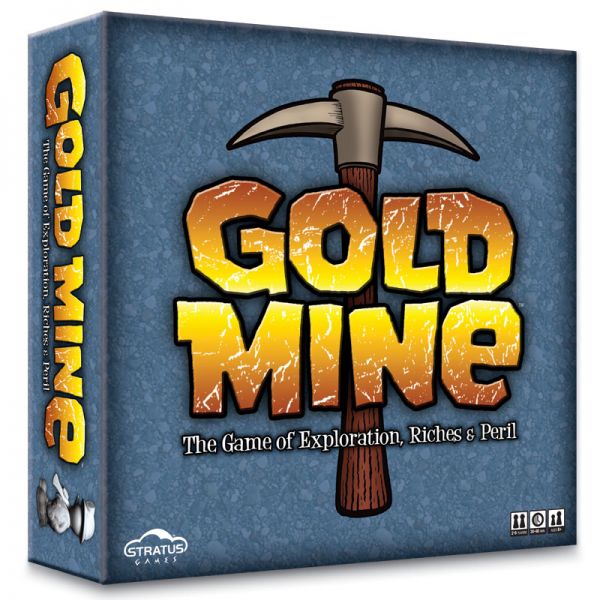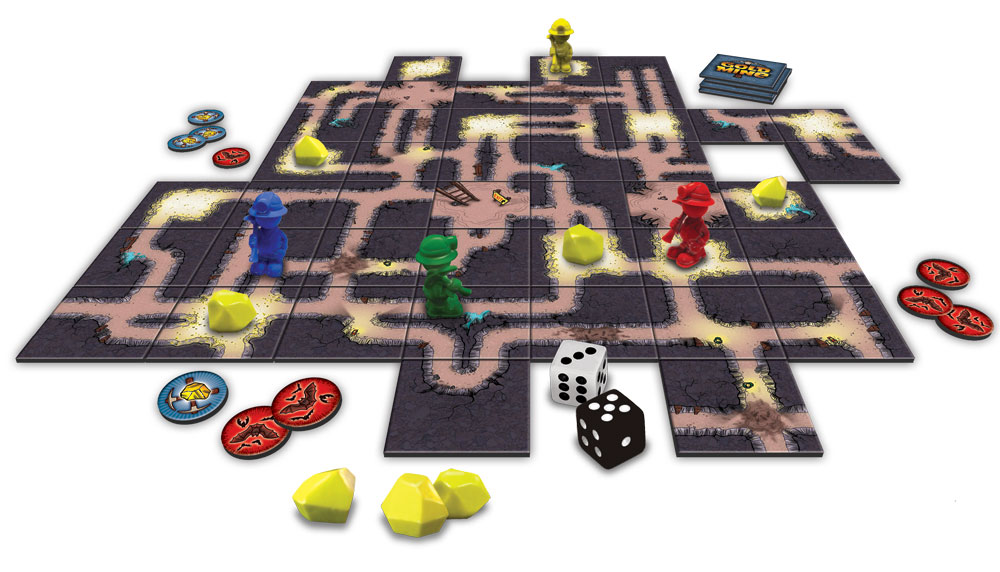The Closet Report: Gold Mine

"I totally 'dig' it!!"
I am Jonathan Albin, the Game Market Guru, and this is the next installment of "The Closet Report," my in-depth and detailed analysis of tabletop games of every stripe. The Closet Report captures and outlines the merits, values, and details about these games in terms that a casual player or a die-hard veteran will appreciate, providing not only the "straight skinny" on the product in terms of the big 3 (Class, Character, and Creativity) but also in terms of Materials, Marketing, and Mechanics, as well as identifying areas of imagination, innovation, and ingenuity.
As our target for this report, allow me to introduce Gold Mine, an entry from Stratus Games that explores the interactions between players in a cooperative/competitive game of gathering gold.
Overview
A tile-based game for between 2 and 6 players, Gold Mine transports the players into an abstract mining environment that is different each time it is played. Geomorphic tiles make up the play area, with each new tile placed bringing the possibility of treasure and danger. Players do have the opportunity to futz with one another through tokens that trigger Bat Challenges, unleashing bat attacks to hinder opponents, and Gold Challenges, last-minute attempts to steal the hard-won gold in order to prevent another player from winning. The amount of interference will depend on the player mix, but fortunately there is an equitable limit to the hindrance that can be exerted.
Game setup begins with a Development Mine layout formed by collectively placing 20 random geomorphic tiles, linked together to create a skeleton of a mining area. Any Gold Chamber tiles (which have a visibly different look) have Gold Nugget markers placed on them. (These are 'easy pickings' for players lucky enough to get to move onto them). When the initial mine is laid out, all players begin on the Mine Entrance tile. Each player will have one Miner token, chosen from six different colors.
Each turn consists of 2 phases: Miner Movement and Miner Action. During the movement phase, the player can choose to excavate (draw and place a tile and optionally move 1 space), roll and move (roll a die and move up to that number of spaces), or opt out of movement. During the action phase, the player can pick up a Gold Nugget and/or discard a token to initiate a Challenge. Bat and Gold Challenges are resolved by choosing an opponent and rolling 3 times — the higher number for 2 of the 3 rolls wins the challenge, with ties going to the challenger. The winner of the Bat Challenge can roll a die and move the loser up to that number of spaces. The winner of the Gold Challenge dislodges a gold nugget from the loser (who must be on the same tile) and places it on any Gold Chamber tile.
Game setup is simple, and as long as your table is big enough to accommodate all the tiles, the play is intuititive…you are either mining, moving to a place TO mine, or are trying to interfere with the person who is closest to winning, to delay them if possible. The winner is the first player to collect the required number of nuggets (10 for a two-player game, down to only 5 for the 5- or 6- player games) and escape through the mine entrance.

To date, Gold Mine does not have organized play programming, but certainly it has enough competitive aspects to be one that could be set up as such. The Closet Report is based on casual play, not on competitive play, but www.theGameMarketGuru.com has information about how to set up tournaments and even Team OP for this and other games titles.
The game has limited availability through standard hobby retail stores, and is not currently available through most hobby distributors, but is available through the manufacturer’s website, www.StratusGames.com and other online sources.
Below are the somewhat wonky, somewhat useful characteristics The Closet Report reveals about the product, and of its game play.
Statistics
-
Total Time to Play – TTP: 40:00
Total time including OBT, PT, and BIB. -
Out of the Box Time – OBT: 2:30
Time to open the box and set up pieces for the game. -
Play Time – PT: 30:00 for casual game. Initial game time can be significantly longer.
Time from beginning of game to resolution, i.e., winner, draw, or quit. -
Back in Box Time – BIB: 2:30
Time required to put game back in the box configuration and return to the closet. -
Time Per Turn – T/T: 0:30
Generally half a minute per player. Limited choices, fast decisions. -
Turns per Game – TPG: 20 per player.
Number of turns in an average game. Can be significantly higher or lower, depending on luck and player interference with one another. -
Turns to Engagement – TTE: 2-8
Number of turns before players must interact. It seemed that it was between two and eight turns before players began to interfere with other players' actions. -
Fun Per Turn – FPT: 80%
Indicates how much enjoyment is to be derived from any given Turn of the game. For the most part, the visual and tactile nature of the playing pieces were great, and the mischievous nature of the Bat Challenges and Gold Challenges were helpful, even if one’s own mining was going poorly. -
Work per Turn – WPT: 20%
Represents the rough percentage of the turn that feels like "work." Turns of mining got to be a little boring, waiting for another player to choose and play a tile. It did feel like ‘mining’… lots of work for little reward. -
Turns Before Fun – TBF: 2
The number of turns that must elapse before engagement with the other players occurs. The game becomes fun once one or more people have ‘struck gold’. Fortunately, there are enough Gold Chamber tiles to make that happen early. -
Self-teaching time – STT: 4:00
The time it takes to learn the game by only reading the rules with no demonstration. As a veteran of the game, I was able to shorten, but honestly one of the most difficult games to teach, despite the lack of random factors, and the need for precision in orders. -
Closet Time – CT: 1 month (or until another episode of "Dangerous Mining" comes on the Learning Channel)
Average length of time between plays. Though I love the game, t is a miracle to get players and the long time frame ever to match up. Maybe I can schedule now for Christmas 2016...
Play Ratings
Numerical ratings from 1 to 10 on various aspects of the game. See each for a scalar definition.
-
Aggression (categorizes the rules by oppositional dynamics)
Scale from cooperative (1) to stridently adversarial (10) – Score: 4 -
Beauty (categorizes the rules by sheer aesthetics; is it “pretty”?)
Scale from functional (1) to art gallery quality (10) – Score: 7 -
Complexity (categorizes the rules by how easy or difficult to comprehend)
Scale from expected (1) to intricate beyond comprehension (10) – Score: 4 -
Depth (categorizes the rules in terms of subtlety)
Scale from shallow (1) to unbelievably nuanced (10) – Score: 3 -
Engagement (categorizes the rules in terms of player interaction)
Scale from parallel play (1) to strong need for teamwork (10) – Score: 5 -
Fun (categorizes the rules in terms sheer derived pleasure)
Scale from mildly amusing (1) to fall on the floor laughing (10) – Score: 5 -
Innovations Quotient (IQ) (identifies any characteristics that make the game unique)
Numeric rating, and each “point” is defined that make this product memorable – Score: 7
Innovation in this game is the use of an abstract enemy: the bats. Mitigates the animosity that a game based on greed can inflict. The amount of tit-for-tat was proportionate…if one player is snippy, the others become so. Clever.
Miscellaneous
Breakout Events are the times and circumstances where this game may shorten its Closet Time, or otherwise help it "break out" of the closet.
- Gold Mine is perfect for "Breakout" when you need an opportunity to get gold. I found it particularly satisfying on tax preparation day, for example.
Shelf Rating is the overall game shelf rating, when compared with every other game in the closet. Scores will vary as new games come into being, and based on other characteristics such as marketing and promotions of similar games.
- Gold Mine is a great game for playing with children, as the Miner tokens and Nuggets are chunky and have a very tactile value. It will be low on the shelves, because it is simple enough the kids can play it by themselves with little or no supervision. (NOT for the very young…the Nuggets look almost edible! Keep out of reach of toddlers. Or grandpa. I can see my own grandfather trying to nibble on the nuggets!)
Editor's note: this game was designed and published by the editor, but reviewed by a 3rd party reviewer. While some changes were made to the rule explanation for accuracy, all commentary was only touched for minor grammatical corrections.








Best Tax Preparation Services in NYC - Tax King Service